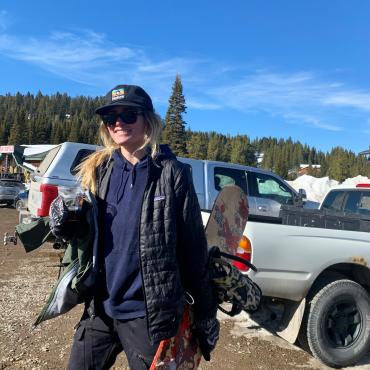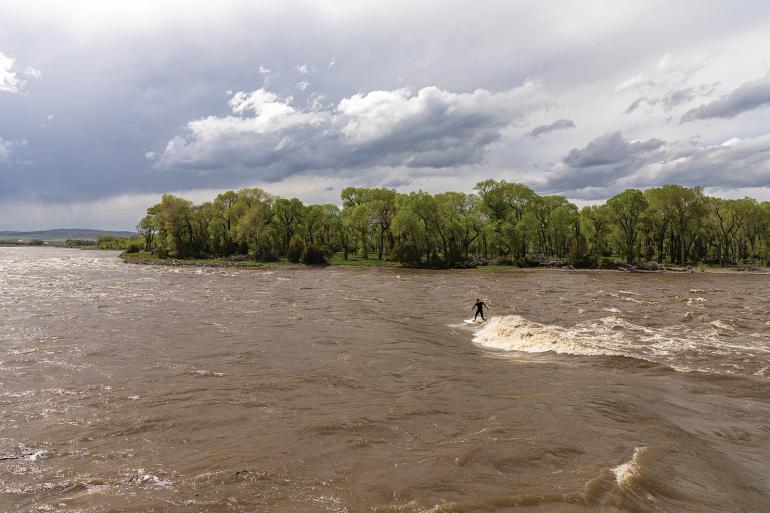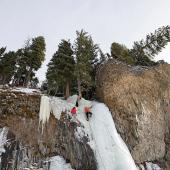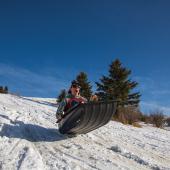Ticket to Surf
A whitewater subculture's growing popularity.
On a warm spring day, we checked the streamflow. There was still snow on the ground, but in the sun you could wear just a t-shirt. I felt a combination of excitement and confusion as we loaded up a friend’s van with surfboards. A car packed to the brim with surfboards? In Montana? I had never heard of someone surfing in a landlocked state. But there we were, with boards, wetsuits, and leashes, ready to hit the river.
River surfing isn’t a new sport—people have been riding standing waves in Wyoming, Colorado, and Idaho for years—but its popularity is increasing in Montana. The thrill is similar to riding waves on the ocean. But waves on the river are consistent, which means less time fighting locals for the biggest and best, and more time enjoying the length of your ride. Though still considered niche ‘round these parts, crowding is becoming a more prevalent issue each year. It’s not on par with finding a place to park at Bridger on a weekend, but Bozeman doesn’t have a town wave. Without that easy and immediate access, folks are forced to expand their horizons to natural waves, which, depending on your perspective, are few and far between in southwest Montana.
After 45 minutes of driving, we pulled off on a long dirt road, passing by big houses and bigger farmlands. My friend looked at me through his rearview mirror and said, “We’re going on private property. Don’t post anything on social media, and don’t blow up our spot, okay? We built a new fence for the woman who owns the land and she’s granting us access.” I agreed. We pulled off on the side of the road, unloaded, and made our way down a footpath toward the water as a their photographer-friend snapped hundreds of photos. No social media, huh? Interesting request...
I gasped when I saw the beautiful, free-standing wave. My friends jumped into the river one by one and started surfing, with the occasional fall sucking them way downstream. My heart was in my stomach when I finally got to the front of the line. But then, all of a sudden, I was surfing on a river, staring at the surrounding peaks which held the surging runoff not a month before.
The thrill is similar to riding waves on the ocean. But waves on the river are consistent, which means less time fighting locals for the biggest and best, and more time enjoying the length of your ride.
As with many outdoor sports, the southwest Montana surf scene has a few gatekeeping dude-bros trying to mark their territory. But I sometimes question why people are so predisposed to keeping a two-foot wave in the middle of Montana, and the access to it, a secret. Of course, the community is filled with passionate people putting in hard work to protect public and private access. Crowding makes surfing less fun, and newcomers who don’t respect local advice and protocol can jeopardize our right to be there. I get it—I waited in line for 20 minutes for a 45-second surf and then had to wait another 20 to do it again. And when it comes to surfing, some of the best waves are only “in” for a few days of the entire season. So how do you balance that?
But the few popular and crowded places aren’t the only ones out there. The Yellowstone is hundreds of miles long, and new discoveries still await. My friends have been able to find new waves simply by asking kayakers, fly fishermen, and other knowledgeable people on the river. At the end of the day, we’re all trying to enjoy nature and sport, spending a day in the sun and on the water. And with that, it’s worth considering that collaborating with others might actually result in more access to the places we all hold dear. River-surfing newcomers should acknowledge the work that’s been done by locals and respect tips and protocol. On the other side of the coin, the aforementioned dude-bros could lighten up a bit, because let’s face it: a knee-high wave isn’t worth fussing over.













